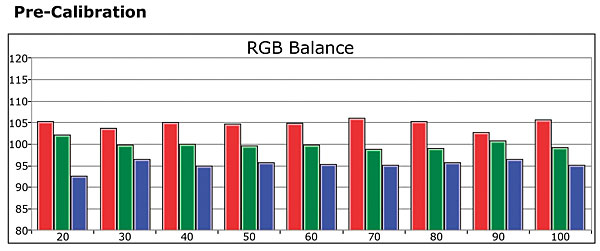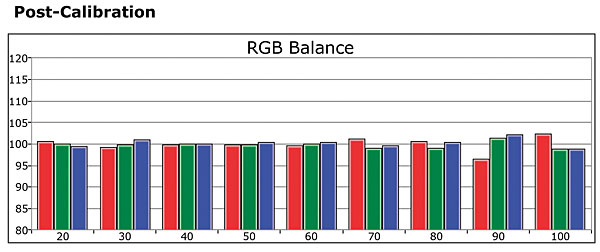Vizio M65-C1 LCD Ultra HDTV Review Test Bench
The measurements here were made using CalMan measurement software from SpectraCal, together with Photo Research PR-650 and Klein K-10A color meters, and the AVFoundry VideoForge 2K and DVDO 4K pattern generators.
Full-On/Full-Off Contrast Ratio: 46,857:1


Unlike with most full-array local dimming, with a full black test pattern on the screen the Vizio’s LED lighting doesn’t shut down completely but rather simply goes very (but measurably) dark. At a peak white light output of 32.8 foot-lamberts, the black measured 0.0007 ft-L (this varied a bit from reading to reading, but most of my several readings clustered around 0.0007). Turning the Active LED Zones off with no other control changes increased the peak white level to 42.1 and the black level to 0.0099, for a full-on/full-off contrast ratio of 4,253:1.
In the Calibrated Dark default setting (but adjusted for a peak white level of 36 ft-L), the pre-calibration grayscale Delta E values averaged 3.5, with a low of 1.33 at 30% and a high of 6.17 at 100%. After calibration (now in a significantly modified Calibrated mode with the peak white level changed to a more dark-room-tolerable 31.3 ft-L), and using mainly the 2-point white balance controls and only the 90% and 100% 11-point controls for a final tweak, the average Delta E dropped to 1.1, with a low of 0.1 at 20% and a high of 3.23 at 90%.
Delta E is a figure of merit that indicates how closely a display adheres to the Rec. 709 HD color standard. Experts generally agree that at levels below 3 to 4, the result is visibly indistinguishable from perfect color tracking. A Delta E may be used to characterize either white balance (grayscale), as above, or color, as below.
None of the color management system controls were ultimately used to calibrate the set’s final color gamut, as discussed in the main review. Nevertheless, after the white balance calibration, the color Delta E averaged a respectable 1.63. Blue, as is typical, was the main offender, with a Delta E of 3.31.

With the Gamma control set to 2.2, the set’s gamma averaged 2.4. But it wasn’t particularly uniform, measuring 2.34 at 20%, 2.2 at 60%, and increasing above that to 2.48 at 70% and 2.97 at 100%. Changing the Gamma setting to 2.1 dropped the average to 2.32, but with a similar rise at the top end. The higher the gamma number at a specific brightness level, the darker the picture will be at that specific level.—TJN



























































